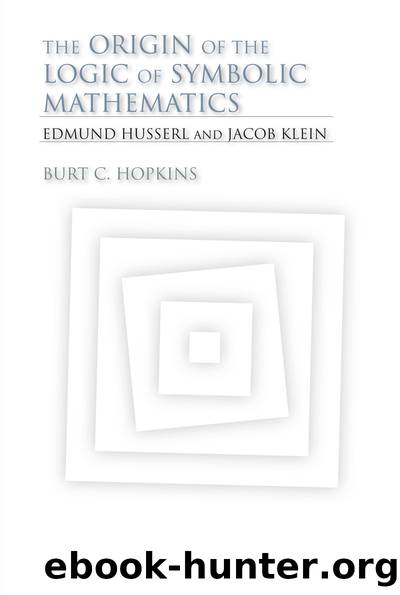The Origin of the Logic of Symbolic Mathematics by Burt C. Hopkins

Author:Burt C. Hopkins
Language: eng
Format: epub, pdf
Publisher: Indiana University Press
Published: 2011-06-15T00:00:00+00:00
§ 104. The Auxiliary Status of Vietaâs Employment of the âGeneral Analyticâ
Klein writes, âVieta explicitly notes that properly speaking these alone, âzeteticâ and âporistic,â are intended in Theonâs definition of analysis.â Vieta defines âzeteticâ âas the procedure âthrough which the equation or the proportion is found which is to be constructed with the aid of the given magnitudes with a view to the magnitude sought,â â and âporisticâ âas the procedure âthrough which by means of the equation or proportion the truth of the theorem {!} set up {in them} is investigatedâ â (170/167).136 However, to these two types of analysis, which belong to the analytical art, âVieta adds still a thirdâ (170/166), which he defines âas the procedure âthrough which the magnitude sought is itself produced out of the equation or proportion set up {in canonical form}â â (170/167).137 Depending on whether the magnitude to which it leads is arithmetical or geometrical, this third type of analysis is called, respectively, ârhetic (ηÏικ) with respect to the definite amounts to which it leads and which can be expressed by the ordinary numeral names of our languageâ (172/167) and âexegetic (ξηγηÏικ) in respect to the geometric magnitudes which it makes directly available to sight.â
This third and final stage âin the solution of an equation, which, as we have seen . . . is actually already a part of the synthesis,â is ânevertheless understood by Vieta as an analytical procedureâ (172â73/167). Indeed, according to Klein, â âSynthesisâ in Vieta generally takes second place to âanalysis,â although in geometric problems he frequently makes use of it and recognizes its traditional priorityâ (172 n. 105/268 n. 235). Hence, Vieta âsays expressly that the results of the analysis have to brought âunder the order of the artâ (in artis ordinationem) according to the âlawsâ (leges) ÎºÎ±Ï ÏανÏÏ, καθâ αÏ, ÎºÎ±Î¸Î»Î¿Ï ÏÏÏον (i.e., in school language: predicated âof every instance of its subject,â âessentially,â âcommensurately with the universalâ).â Klein reports that for Vieta the â âlaw of every instanceâ â is something that â âessentiallyâ demands that every ârule of the artâ (artis decretum) be âof the same genus and a member of the same body as it wereâ. . . .â Thus, âsuch results âas are demonstrated and firmly established by zeteticâ . . . must be subjected to âsynthesis,â âwhich is commonly considered the logically tighter way of demonstrationâ . . . ; this means that âthe tracks of analysis are thus repeatedâ. . . .â Vieta, however, âsignificantly adds, âthis is itself also analyticalâ (quod et ipsum analyticum est),â as well as â ânot troublesome, on account of the species calculation introducedâ . . . by him.â138
Klein reports that Vieta considers ârheticâ and âexegeticâ to be âthe most important part of the âanalyticâ â art (175/168), sinceâunlike the other two parts, âzeticâ and âporistic,â which âconsist essentially of âexamplesâ (exempla)ââeach of these âcomprises a series of ârulesâ (praecepta).â Because of â[t]his organization of the âanalyticâ â (175/168), Klein maintains that the â âgeneral
Download
The Origin of the Logic of Symbolic Mathematics by Burt C. Hopkins.pdf
This site does not store any files on its server. We only index and link to content provided by other sites. Please contact the content providers to delete copyright contents if any and email us, we'll remove relevant links or contents immediately.
Modelling of Convective Heat and Mass Transfer in Rotating Flows by Igor V. Shevchuk(6392)
Weapons of Math Destruction by Cathy O'Neil(6152)
Factfulness: Ten Reasons We're Wrong About the World – and Why Things Are Better Than You Think by Hans Rosling(4696)
Descartes' Error by Antonio Damasio(3232)
A Mind For Numbers: How to Excel at Math and Science (Even If You Flunked Algebra) by Barbara Oakley(3224)
Factfulness_Ten Reasons We're Wrong About the World_and Why Things Are Better Than You Think by Hans Rosling(3201)
TCP IP by Todd Lammle(3137)
Fooled by Randomness: The Hidden Role of Chance in Life and in the Markets by Nassim Nicholas Taleb(3050)
Applied Predictive Modeling by Max Kuhn & Kjell Johnson(3020)
The Tyranny of Metrics by Jerry Z. Muller(3008)
The Book of Numbers by Peter Bentley(2913)
The Great Unknown by Marcus du Sautoy(2651)
Once Upon an Algorithm by Martin Erwig(2602)
Easy Algebra Step-by-Step by Sandra Luna McCune(2586)
Lady Luck by Kristen Ashley(2537)
Practical Guide To Principal Component Methods in R (Multivariate Analysis Book 2) by Alboukadel Kassambara(2497)
Police Exams Prep 2018-2019 by Kaplan Test Prep(2489)
All Things Reconsidered by Bill Thompson III(2358)
Linear Time-Invariant Systems, Behaviors and Modules by Ulrich Oberst & Martin Scheicher & Ingrid Scheicher(2334)
